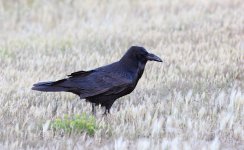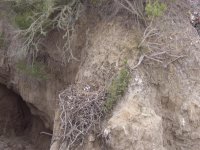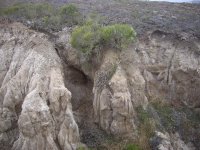[This will require some background info. and descriptions so it’ll be a bit long.]
As a biologist working for the National Park Service I spent 4 years observing and monitoring the endangered island fox population on San Miguel Island (SMI)--this is one of the 5 islands of Channel Islands NP. The island has a resident population of common ravens. I've always been fascinated by ravens. So, though the foxes were the focus of my work I also liked to keep an eye on the ravens whenever I could. I found the SMI ravens to be somewhat distinct. In particular, I noted a few intriguing and unique features in this population that I have not observed in other raven populations that I've encountered. One of these features is the common occurrence of brown feathers among the population. This feature was variable, ranging from being absent to a mottling of brown to large patches of brown feathers (in fact, I saw some individuals whose tail feathers were mostly or entirely brown, and two ravens whose entire head and neck was brown, similar to that of a male brown-headed cowbird).
However, most intriguing of all was a feature of the beak that was present on most (but not all) of the SMI ravens that I saw (it wasn't until I had been on the island for a while that I finally saw some ravens who lacked this feature). This particular feature occurred on the front (distal) half of the beak--it was (mainly) an arching along the distal occlusal side of the upper beak that may or may not also have some concavity along the adjacent occlusal section of the lower beak. This formed an open gap in this section of the beak when it was fully closed that you could see through when viewing the closed beak in profile. I attached a photo that illustrates this feature so that you can better see what I'm describing (note also the scattered patches of brown feathers).
The gap is variable in size among individuals; the one on the raven in the photo is about at the upper extreme. This is a feature that I've only ever seen on these SMI ravens. I've seen ravens from much of their U.S. range but I never saw it on any of them. Nor did I see it in the raven populations of the neighboring Channel Islands (Santa Rosa, Santa Cruz and Anacapa) and adjacent mainland areas. I've also viewed many raven photos online and over 30 raven specimens in a nearby museum collection and didn't see it in any of these.
I'm especially intrigued re. the origin of this beak feature. Is it a distinct genetically encoded characteristic of this island population or is it perhaps a use-wear thing? SMI is essentially treeless. There are just a few willows that I consider to be trees in a small section of one the canyons on the island. There is also a stand of 4 palm trees that were planted beyond the upper end of a beach some years ago. Other than these, the island is treeless. The SMI ravens predominantly feed on the ground and are commonly seen poking their beak into or digging in the dirt. Is this something that wears away at the beak and thus produces this feature? Interestingly, I didn't see this feature on the handful of fledglings that I saw but it wasn't clear if their beak growth and development was as yet fully completed--if it was, this would add support to a use-wear origin. Seasonally the SMI ravens also eat the fruits of iceplants. Is this beak feature in some way connected to this, either in the manner that the ravens harvest and prepare these fruits or perhaps due to these fruits being somewhat acidic and corrosive (I asked a park botanist if these fruits were slightly acidic and he said that they likely were)? Whatever the cause of this unique beak feature it is an intriguing matter that would make for an interesting study topic as would the SMI population in general.
I’m curious as to whether anyone else has seen this feature in common raven populations in your areas? Anyway, there’s some interesting stuff going on with the SMI raven population. It’s the most distinct common raven population that I’ve seen and I believe it’s well worthy of an in depth study.
I also attached a few photos of one of the raven nests. It was constructed on the wall of one of the island's canyons. Though it's difficult to see, there is one young chick in the nest (on a happy note, this chick successfully fledged). With the island being treeless, possible nesting sites were at a premium, especially in light of the island's fox population.
As a biologist working for the National Park Service I spent 4 years observing and monitoring the endangered island fox population on San Miguel Island (SMI)--this is one of the 5 islands of Channel Islands NP. The island has a resident population of common ravens. I've always been fascinated by ravens. So, though the foxes were the focus of my work I also liked to keep an eye on the ravens whenever I could. I found the SMI ravens to be somewhat distinct. In particular, I noted a few intriguing and unique features in this population that I have not observed in other raven populations that I've encountered. One of these features is the common occurrence of brown feathers among the population. This feature was variable, ranging from being absent to a mottling of brown to large patches of brown feathers (in fact, I saw some individuals whose tail feathers were mostly or entirely brown, and two ravens whose entire head and neck was brown, similar to that of a male brown-headed cowbird).
However, most intriguing of all was a feature of the beak that was present on most (but not all) of the SMI ravens that I saw (it wasn't until I had been on the island for a while that I finally saw some ravens who lacked this feature). This particular feature occurred on the front (distal) half of the beak--it was (mainly) an arching along the distal occlusal side of the upper beak that may or may not also have some concavity along the adjacent occlusal section of the lower beak. This formed an open gap in this section of the beak when it was fully closed that you could see through when viewing the closed beak in profile. I attached a photo that illustrates this feature so that you can better see what I'm describing (note also the scattered patches of brown feathers).
The gap is variable in size among individuals; the one on the raven in the photo is about at the upper extreme. This is a feature that I've only ever seen on these SMI ravens. I've seen ravens from much of their U.S. range but I never saw it on any of them. Nor did I see it in the raven populations of the neighboring Channel Islands (Santa Rosa, Santa Cruz and Anacapa) and adjacent mainland areas. I've also viewed many raven photos online and over 30 raven specimens in a nearby museum collection and didn't see it in any of these.
I'm especially intrigued re. the origin of this beak feature. Is it a distinct genetically encoded characteristic of this island population or is it perhaps a use-wear thing? SMI is essentially treeless. There are just a few willows that I consider to be trees in a small section of one the canyons on the island. There is also a stand of 4 palm trees that were planted beyond the upper end of a beach some years ago. Other than these, the island is treeless. The SMI ravens predominantly feed on the ground and are commonly seen poking their beak into or digging in the dirt. Is this something that wears away at the beak and thus produces this feature? Interestingly, I didn't see this feature on the handful of fledglings that I saw but it wasn't clear if their beak growth and development was as yet fully completed--if it was, this would add support to a use-wear origin. Seasonally the SMI ravens also eat the fruits of iceplants. Is this beak feature in some way connected to this, either in the manner that the ravens harvest and prepare these fruits or perhaps due to these fruits being somewhat acidic and corrosive (I asked a park botanist if these fruits were slightly acidic and he said that they likely were)? Whatever the cause of this unique beak feature it is an intriguing matter that would make for an interesting study topic as would the SMI population in general.
I’m curious as to whether anyone else has seen this feature in common raven populations in your areas? Anyway, there’s some interesting stuff going on with the SMI raven population. It’s the most distinct common raven population that I’ve seen and I believe it’s well worthy of an in depth study.
I also attached a few photos of one of the raven nests. It was constructed on the wall of one of the island's canyons. Though it's difficult to see, there is one young chick in the nest (on a happy note, this chick successfully fledged). With the island being treeless, possible nesting sites were at a premium, especially in light of the island's fox population.







